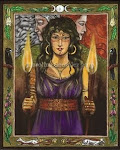
This month's giveaway comes to us from The Whimsical Pixie. The owner Paula, has donated a gorgeous Pagan ornament for your Yule/Christmas tree! Her ornaments are some of the most beautiful I've seen! I've already purchased one for myself as well. I had the chance to speak with Paula, here's what she had to say:
1. How long have you been crafting magical products?
Its been a little over 3 years since I've started creating magickal ritual items to sell. It all started because I wanted to make my sister a set of runes; did a Google search for tutorials and found a great one using polymer clay. One link led to another revealing the versatility of the clay and this Pixie took flight!
2. Do you have a favorite product that you make?
In as much as I love creating everything in my Etsy shop, I enjoy the Custom Altars the most. Creating these allows me to get to know the buyer in a more intimate manner. They are by far the most personalized item I create as the person selects the ritual tools, color combination and pyrographed designs. They also allow me to utilize different art mediums which gets the creative juices flowing.
3. Please explain the item you are giving away.
The Triple Moon Goddess and Pentagram Ornament was created using millefiori technique, a very old art form also used for glasswork. Translated millefiori literally means a thousand flowers. Polymer clay is used to fabricate “canes” of different designs; the cane can be reduced in size yet the design of the cane remains the same throughout. Thin slices are then taken from the cane and laid individually on an object to create something truly unique and beautiful. All polymer clay canes are made by me. The cap can be removed to allow you to fill the ornaments with herbs, oils or crystal to your specific intent.
Ok so now to enter, go to The Whimsical Pixie, find a product or two that you like, come back here and comment on them. Also be sure to check out The Whimsical Pixie's Facebook Page! The winner will be picked using random.org, and will be announced in one week. Have fun playing and good luck! Thanks to Paula for donating her beautiful ornament!








